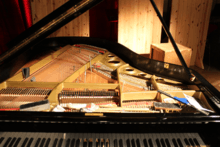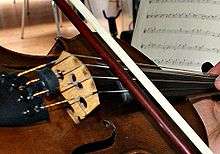Prepared piano


A prepared piano is a piano that has had its sound altered by placing objects (called preparations) on or between the strings.
Technique
Although theoretically any object could be used to prepare a piano, in practical application preparation objects are usually expected to have certain characteristics:
- They are applied directly to the piano strings.
- They must fit in the desired location inside the piano.
- They (usually) should not move from their location during playing.
- They must be reversible (that is, when a properly prepared piano has been "unprepared", it should be impossible for anyone to tell that it had ever been prepared; no permanent damage is done to the piano).
Additionally, most preparations will change the timbre of the string in such a way that the original pitch of the string will no longer be perceptible, though there are occasional exceptions to this.[1]
Historical precedents
Delage
In his Ragamalika (1912–22), based on the classical music of India, French composer Maurice Delage (1879–1961) calls for a piece of cardboard to be placed under the B-flat in the second line of the bass clef to dampen the sound, imitating the sound of an Indian drum.[2]
Cowell
In 1922 American Composer Henry Cowell (1897–1965) pioneered a technique he dubbed "string piano", which involved having the pianist reach inside the piano and pluck, sweep, scrape, thump, and otherwise manipulate the strings directly, rather than using the keyboard. He developed these techniques in pieces such as Aeolian Harp (1923) and The Banshee (1925).[3] Although Cowell's techniques don't call for placing objects (other than the hands) inside the piano, Cage frequently cited Cowell's work as the primary inspiration for his development of the prepared piano.[4]
Villa-Lobos
In his Choros no. 8, a 1925 work for two pianos and large orchestra, Heitor Villa-Lobos added to his score instructions to the pianist to insert pieces of paper between the strings and the hammers to attain a certain sonority.[5]
John Cage
The invention of the "prepared piano", per se, is usually traced to John Cage. Cage first prepared a piano when he was commissioned to write music for "Bacchanale", a dance by Syvilla Fort in 1938. For some time previously, Cage had been writing exclusively for a percussion ensemble, but the hall where Fort’s dance was to be staged had no room for a percussion group. The only instrument available was a single grand piano. After some consideration, Cage said that he realized it was possible “to place in the hands of a single pianist the equivalent of an entire percussion orchestra ... With just one musician, you can really do an unlimited number of things on the inside of the piano if you have at your disposal an exploded keyboard”.[6]
In popular music
- Ferrante & Teicher, were American piano duo who produced over a hundred albums of light classical and popular "easy listening" in their long careers (1947-1992). Between 1950-1980 they included partially prepared pianos on a number of their tunes to add percussive effects.[7]
- "All Tomorrow's Parties" from The Velvet Underground & Nico (1967), John Cale prepared his piano with a chain of paper clips.[8]
- Denman Maroney performs on what he has dubbed hyperpiano, which "involves stopping, sliding, bowing, plucking, striking and strumming the strings with copper bars, aluminum bowls, rubber blocks, plastic boxes and other household objects."[9]
- Since 1982, Roger Miller has fashioned his own take on prepared piano in his work. Initially featured on Mission of Burma's 45 "Trem II", Miller has since released many albums (Ace of Hearts, SST, New Alliance, Atavistic, Matador) incorporating this technique. His concert hall compositions, from 2009 to present, often utilize prepared piano."[10][11][12]
- On his 1973 album Another Green World, composer Brian Eno employed prepared piano on the track entitled "Little Fishes".
- German band Tangerine Dream includes prepared piano on their 1975 album Rubycon.
Related techniques
Tack piano
Strictly speaking, a tack piano is not a prepared piano, since
- No objects are inserted into or onto the strings.
- The strings' original pitches remain perceptible.
- Piano preparations are reversible.
Although the tacks can be removed from the hammers, inserting them causes permanent damage to the felt, and for this and other reasons the use of tacks is generally discouraged by piano technicians.[13]
Acoustisizer
The Acoustisizer is an electroacoustic musical instrument built from a small grand piano with built in speakers, magnetic guitar pickups, PZMs, and prepared piano strings. It was built as part of a graduate thesis project at California State University Dominguez Hills by Bob Fenger (1983), a student of Richard Bunger (author of the Well Prepared Piano). Speakers are built into the bottom of the instrument, redirecting its own amplified sound back onto the sounding board, with strings and magnetic pickups creating an amplitude intensity loop which in turn drives and vibrates suspended kinetic oscillators (assemblages of vibration sensitive materials). Secondary control parameters allow extraction of vibration and sound phenomena from the kinetic oscillators through a series of proximity microphones and PZMS (piezo electric contact mics). An article was written by the inventor and was published in Experimental Musical Instruments Magazine April 1991, Nicasio CA.[14] It includes pictures of the kinetic oscillators and stages of the construction process including an underbody view of the speaker system configuration.[15]
See also
References
- ↑ Bunger, Richard (1973). The Well-Prepared Piano. Colorado Springs: Colorado College Music Press
- ↑ Pasler, Jann (2000). "Race, Orientalism, and Distinction in the Wake of the 'Yellow Peril'." In Western Music and Its Others: Difference, Representation, and Appropriation in Music, ed. Georgina Born and David Hesmondhalgh. Berkeley, Los Angeles, and London: University of California Press, p. 107.
- ↑ (Bartok, Peter, Moses Asch, Marian Distler, and Sidney Cowell; revised by Sorrel Hays (1993 [1963]). Liner notes to Henry Cowell: Piano Music (Smithsonian Folkways 40801). p. 12 (unpaginated)
- ↑ Nicholls, David (1991 [1990]). American Experimental Music 1890–1940. Cambridge, New York, and Melbourne: Cambridge University Press. (p. 523) ISBN 0-521-42464-X
- ↑ Anna Stella Schic (1987). Villa-Lobos, Souvenirs de l'Indien Blanc, Actes Sud, p. 82.
- ↑ Cage, John, and Daniel Charles (1981). For The Birds: John Cage in Conversation with Daniel Charles. Marion Boyers London. ISBN 0-7145-2690-8.
- ↑ Huey, Steve; Rovi. "Ferrante & Teicher Biography". CMT. Retrieved 28 October 2010.
- ↑ Mitchell, Tim Sedition and Alchemy : A Biography of John Cale, 2003, ISBN 0-7206-1132-6
- ↑ "Philadelphia FRINGE Festival 2000 - Hyperpiano". Archived from the original on 2007-12-31. Retrieved 2005-12-23..
- ↑ Pareles, Jon (1987-06-05). "Music: Roger Miller". NYTimes.com. The New York Times. Retrieved 2014-02-15.
- ↑ Burke, Kathleen (2012-06-19). "Fuse Feature: M2 — 'At Land's Edge' Album Review/Interview". ArtsFuse.org. The Arts Fuse. Retrieved 2014-02-15.
- ↑ Gottschalk, Jennie (2013-07-02). "The Mush Race of Boston: The SICPP 2013 Iditarod". NewMusicBox.org. New Music USA. Retrieved 2014-02-15.
- ↑ http://www.perfessorbill.com/help/help.htm
- ↑ Fenger, Bob Icon. "The Acoustisizer" Nicasio CA, Volume 6 #6 April 1991.
- ↑ Fenger,Bob, "The Acoustisizer" Joshua Tree CA, April 1991
Further reading
- Bunger, Richard (1973). The Well-Prepared Piano. Colorado Springs: Colorado College Music Press
- Fürst-Heidtmann, Monika (1979). Das präparierte Klavier des John Cage. Gustav Bose Verlag Regensburg. ISBN 978-3-7649-2183-5.
- Dianova, Tzenka (2008). John Cage's Prepared Piano: The Nuts & Bolts. Mutasis Books Victoria. ISBN 978-0-9809657-0-4.
External links
- 'Are You Prepared' 17-key Online Prepared Piano by Andreas Busk. Site includes free downloadable prepared piano sampler for Ableton Live, NI's Kontakt and Logic's EXS Sampler
- The Sound Collector - The Prepared Piano of John Cage by Tim Ovens (PDF version).
- If you build it, they will come! essay by Kyle Gann, includes video performance of preparation by Margaret Leng Tan (here).
- Prepared Piano Sample Set - By Tom Gersic. Some free, others cheap
- Prepared Piano Max/MSP-Object - By Dr. Stefan Bilbao, ported to Max/MSP by Thomas Resch
Listening
- Prepared piano demonstration and performance by Richard Bunger
- Epitonic.com: John Cage performed by Margaret Leng Tan, featuring In the Name of the Holocaust
